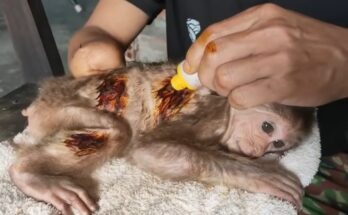In the wild, the Komodo dragon is known not only for its size and power but also for its patience and strategic hunting style. When targeting a small goat, the Komodo dragon does not simply rush its prey. Instead, it observes quietly, using stealth and timing to its advantage. Every movement is calculated, every step taken with purpose.
The hunt usually begins with the Komodo dragon lying in wait, partially hidden behind rocks, bushes, or fallen trees. Its dark, rough skin blends into the surroundings, making it nearly invisible to the unsuspecting goat. The dragon stays motionless, watching carefully as the goat grazes nearby, unaware of the danger creeping closer.
When the time is right, the Komodo dragon slowly begins to move forward. Its tongue flicks in and out, tasting the air and locking in on the goat’s scent. The dragon moves low to the ground, its muscles tense and ready. It knows it only needs one good strike.
Suddenly, with a burst of speed, the dragon lunges. Its powerful jaws snap onto the goat’s leg or neck, delivering a bite laced with deadly bacteria and venom. The goat struggles and cries out, but escape is nearly impossible. The dragon’s strength and size are overwhelming.
However, the Komodo doesn’t always kill right away. Sometimes it lets the goat go after a bite, knowing the poison will weaken it over time. The dragon will quietly follow the injured animal, watching it slow down, stumble, and finally collapse.
This hunting strategy may seem cruel, but it is part of nature’s design. The Komodo dragon, though slow in appearance, is a skilled and intelligent predator. It uses stealth, patience, and biological weapons to secure its meal.
The image of such a hunt is both terrifying and fascinating—a reminder of how survival in the wild is a game of strategy, not just strength. The small goat never stood a chance against such a masterful predator.


